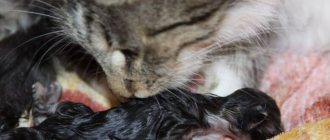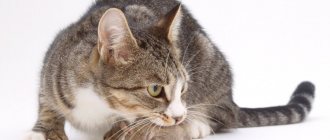When do you need a veterinary passport?
A passport for a cat has nothing to do with documents about its pedigree or birth certificate. These are completely different documents. A veterinary passport for a cat serves as an identification card and a medical card.
International veterinary passport
Owners who are going to travel abroad or travel to different regions of Russia need to have a veterinary passport for a cat. A successful vacation with your pet depends on the correct completion of the document. Before the flight, you need to urgently obtain all the necessary certificates.
With the help of a veterinary passport, it is convenient to monitor the health status of your pet, because it contains all the records about vaccinations, deworming, sterilization, mating, childbirth, etc.
A document with information from the metrics is needed for purebred animals to participate in exhibitions.
For your information! When traveling abroad, all veterinary passport entries are valid for 5 days, not counting the day of departure. In addition, you will need a certificate of microchipping, as well as a veterinary health certificate in Form No. 1.
For transportation you need to collect several documents
Veterinary certificate form No. 1
The passport form contains many fields regarding information about the pet. If general information can be provided by the owner himself, medical information must be filled out only by a veterinarian. For example, let’s look at a sample of filling out an international veterinary passport.
On a note! The appearance of the passport may differ slightly depending on the place of purchase (issue): vertical or horizontal arrangement of columns is possible. The main thing is to fill them out correctly.
To fill it out yourself, it is enough to know how the information should be reflected in it. Firstly, it must be entered only by hand using a pen with blue or black ink. Secondly, you should duplicate the data in your passport in Cyrillic and Latin. For the latter, you can use free online transliteration services. In addition to personal information about himself, the cat owner can independently fill out the following fields:
- Pets photo. This item is filled out at the request of the owner (if there are no plans to cross borders) and the photo is placed in the passport without any stamps. You can do it yourself, but it is recommended to fulfill two conditions: the age of the cat must be 1 year or older, and its appearance in the photo must reflect the characteristic features of its appearance (if any).
- Name of the cat / Name of cat. Indicated with a capital letter. For purebred individuals, it is filled out according to the information from the metric/card received at the nursery, for all others - at your own discretion.
- Breed / Breed. Information from the metric is also indicated here, and for outbred pets it is written “mixed breed”.
- Date of birth. If the exact data is unknown, you can put an approximate date.
- Gender/Sex. If the form indicates Male/Female (male/female), it is enough to indicate or underline the desired value. In other cases, you should enter Female for a cat or Male for a cat yourself. You cannot indicate gender in your passport with the words “female”, “male”, “female”, “male”, etc.
- Color. If there is no metric, it is advisable to check the color tables. Black and white colors can be entered as is, but more complex variations of shades and spotting are recommended to be specified.
- Distinguishing marks. Here the color features, structure or other distinctive features of a particular pet may be indicated (different eye colors, scars, curvature of the tail vertebra, etc.)
Sample of filling out a veterinary passport for a cat
This is where the owner’s filling in information about the pet ends. Fields relating to the identification of the animal are filled out by the veterinarian for animals that have undergone the microchipping procedure.
Medical data
Information about the registration of the cat in the clinic and the procedures performed is filled out by the veterinarian. This applies to the following columns indicating the dates of the procedures and other details of their implementation:
- About vaccination, indicating the name and serial number of the vaccine, pasting a special sticker from the ampoule of the drug, which must be “canceled” with the seal and signature of the veterinarian.
- About the prevention or treatment of helminthic infestations.
- About treatment for ticks and fleas.
- About surgical interventions.
- About reproductive indicators (estrus, mating, childbirth, indicating the number of offspring born).
- About the diagnostic tests carried out
- About the microchipping procedure (if one was carried out): date of implantation, serial number, location of implantation on the animal’s body.
Attention! If the owner gives injections himself and personally vaccinates his cat, then such vaccinations are considered invalid. Vaccination records must be certified only by authorized institutions.
What does the document look like and what data does it contain?
The document contains information about the pet owner and health information. First of all, all vaccinations are listed there.
Veterinary passport for a dog: how to indicate the species
What data is indicated:
- age;
- nickname;
- color, breed;
- name and number of the vaccine, date of vaccination;
- date of any transactions;
- date of deworming;
- date of sterilization;
- dates of estrus, mating, birth;
- number of kittens born;
- Full name and telephone number of the owner;
- chip number, date of its implantation, place on the body where it was installed.
Important! All records must be confirmed by the seal of the veterinary clinic and the signature of the doctor.
In Russia there is no single form of veterinary passport approved by law. There are several common examples:
- International veterinary passport;
- Veterinary passport of St. Petersburg;
- Europass.
In St. Petersburg there is a special example of a veterinary passport, but there is no place for a photograph. All information is duplicated only in Russian and English. But the requirements for filling out this document are quite strict.
Veterinary passport, sample St. Petersburg
Certificate of registration of the cat in the system
In American exhibition systems, the main document for a cat is a registration form, which indicates the registration number of the animal. This document certifies the cat’s membership in the relevant system, and, consequently, the right to receive titles and pedigrees for it at the central office of the organization, and to register the litters received from it.
READ Diarrhea in cows: causes and treatment 2019
In addition to the number, the form indicates the name of the cat, its breed, color, its parents, date of birth, name of the owner and breeder of the animal; the logo of the system and the signature of its secretary (facsimile).
In fact, the registration certificate is also the system's legal proof of cat ownership. Therefore, usually, such a certificate is issued to the new owners of the cat, after purchasing it from the breeder, based on the received metrics. If the breeder registered the cat before the sale, then he is required to issue another document - a transfer.
How to make a veterinary passport for a cat
RKF documents for a dog: what is it and how to do it
Many pet owners are interested in how to make a passport for a cat. To do this, you need to go to a veterinary clinic to have the cat wormed, vaccinated, and sterilized.
Veterinary passport of the European Union sample
Where do you get your passport?
The document is made in a veterinary clinic that has a valid license. There you can buy a form, the doctor will fill it out immediately. Most often, when a kitten is vaccinated for the first time, a veterinary passport is issued and a record of the vaccination given is entered there.
Important! The passport is issued immediately after the first vaccination.
There is no single approved form of veterinary passports, but most owners use international passports
How to take a photo of a cat
A photo in the veterinary passport is necessary to make the pet easier to recognize. A photo must be required, but there are no strict requirements for it. You need to paste any successful photo of a cat over 1 year old. It is necessary that the muzzle and, if possible, the entire body be clearly visible. The photograph must be of good quality, clear, and informative. It is desirable that the background be contrasting (light or white). However, a dark background is better suited for a photo of a white cat.
Note! The photo must fit the size of the veterinary passport. You can print a good photo you took yourself on thick paper, or go to a photo salon.
It is not necessary to put a stamp on the photograph in the veterinary passport.
Need a good photo
How much does it cost to get a veterinary passport for a cat?
Every owner is interested in how much a veterinary passport for a cat costs. It is quite inexpensive, about 50–100 rubles.* Veterinary passports are sold in pet stores and veterinary clinics. If the owners decide to microchip the cat at the same time as obtaining a passport, they will have to spend much more money. It will take no more than 15 minutes to obtain a veterinary passport, but this will greatly simplify the life of cat owners.
Important! A passport and a birth certificate with a pedigree are completely different types of documents that should not replace each other, but complement each other.
Rabies vaccines must be listed
International veterinary passport for cats
Collar for a cat: how to make it yourself
For owners who are going to go on vacation with a cat abroad, a veterinary passport of international standard is required. Entries in the veterinary passport are made in Russian and English. But the vast majority of veterinarians fill out the passport only in Russian. In addition to the veterinary passport, you will need a certificate of vaccination, as well as a certificate of general health.
Note! The passport itself is not a comprehensive document, so problems with documents may arise during travel. All certificates must be prepared in advance, and a special transport ticket must be purchased for the move or flight.
There is another form - a European passport. It is issued only in EU countries for EU citizens. All fields in it must be filled out in 4 languages: Russian, English, German, French. There are no such passports in Russia. Many manufacturers of veterinary passports make exact copies of these documents, but in fact they are no different from a regular Russian veterinary passport, only they are more expensive.
Deworming notes required
Kitten veterinary passport
If the cat is purebred, but there are no documents for it, this can arise for a number of reasons.
Sometimes, when buying a kitten, people forget about the documents: after all, an animal is needed for the soul. And after a while, a problem arises with how to get documents for a cat, which will be extremely difficult to solve. It also happens that documents are lost. In addition to a passport, a cat can also have a pedigree; this document is needed to participate in exhibitions. True, if the cat is not purebred, a pedigree is not needed. It happens that a kitten is bought without a pedigree. In this case, you can arrange it yourself. How to make a pedigree for a cat is described below.
If there is a metric, drawing up a pedigree will not be difficult. The metric is the kitten's birth certificate. You should contact the club that issued this document. The entire procedure will take about three weeks. The cost can vary from 500 to 1500 rubles.
If the club that issued the pedigree to the kitten’s parents is located in another country or in another city, you can ask to send copies of these documents by mail. And with the received copies and metrics, go to the club that issued the metrics.
Let's look at how to make a pedigree for a cat without documents, that is, without a birth certificate. If it was known for sure that the kitten’s parents had pedigrees, you need to contact the seller and agree to receive the metrics. And then proceed according to the already known algorithm.
If the breeder refuses to issue a metric, you can complain about him to the club. Although such refusals often have a good reason: a year has passed since the cat was born, the kitten is not intended for breeding. In the second case, you can draw up a pedigree, but the club will issue a document either with the “PET” stamp or without a number. True, such a pedigree will not have practical significance.
So, when buying a purebred cat, you should draw up documents for it just in case. Today there are no plans to take part in exhibitions, but after a certain time the decision may change.
The veterinary passport indicates the name, gender, breed of the cat, its date of birth, the name of the owner or breeder. But the most important thing is that the passport must contain vaccination records with a special sticker, a veterinary clinic stamp and a doctor’s signature.
Veterinary passports come in different designs. The standard passport is blue with blue security inscriptions “pet”, but if they give you a passport of a different type, it’s okay. Different regions have different requirements, if anything happens, your veterinarian will make you a new correct passport and offer to keep the old one, just in case.
It is important to understand that every purebred kitten must have a veterinary passport, but it does not in any way confirm its breed, since it is filled out by a veterinarian or breeder, and clubs and exhibition systems are authorized to guarantee the breed.
This is the kitten’s birth certificate, which is issued when it is activated in the club system. The metric indicates the kitten's name, its breed, gender, color, date of birth; names and colors of the kitten's parents; name of the breeder, etc. The document must have the emblem of the system to which the kitten belongs.
Also, the metric of the European system must bear the seal of the club that issued it, and the signature of the responsible club functionary who activated the kittens, so that in the future it can be exchanged for a pedigree.
In American systems, based on the metric (slip), a kitten is registered and a pedigree is ordered at the central office.
A European breeder may refuse to give kittens for castration, but he is obliged to at least show it to you. And it’s better to ask her to give her back, the club still knows that the kitten is for castration and will not give you the pedigree just like that.
In American systems, such problems do not arise, since all breeding restrictions are indicated when registering a litter.
The pedigree indicates several generations (3-5) of your kitten’s ancestors (their nicknames, colors and pedigree numbers). The pedigree must contain the emblem of the association (system), the name of the club, nursery, the name of the breeder and the name of the owner of the kitten, information about the kitten itself.
Be careful: in the pedigree, in the “owner” column, your name must be indicated, not the name of the breeder! To do this, you need to either obtain a pedigree yourself, or agree in advance with the breeder on its registration.
In the European system, the pedigree must have a number, the seal of the club and the signature of its leader. In American ones, only the number is indicated, since the pedigree is issued by the system.
If the kitten is to be castrated, then in the European system they may give you a pedigree without a number or with a “pet” stamp, or not issue it at all, but again it would be better to negotiate so that they give it.
If you yourself draw up a pedigree based on metrics in a club specified by the breeder, then you must request it before the kitten turns one year old. This applies only to European systems; in American systems, the owner can request a pedigree based on the breeder slip at any time if the cat has been registered in the system.
However, you will not need a pedigree if you do not engage in breeding.
An agreement for the purchase and sale of a kitten is no different from an agreement for the purchase and sale of other property (according to the law, a cat is property). The full names and passport details of the parties must be indicated there; name, breed and gender of the kitten; kitten price; special conditions.
The contract must be read carefully before signing.
Sample contract
READ Florarium - what it is and how to make it yourself, step by step
How to fill out a passport
Only a veterinarian has the right to fill out a cat’s passport. He writes down the cat's name, what gender it is, when it was born, what it looks like, etc. If the exact date of birth is unknown, you need to indicate an approximate one. In the breed column for outbred cats you need to write “mixed breed”. Then information about operations and vaccinations is filled in. As a rule, this data is recorded immediately after the procedure. All entries in all sections of the passport are made in two languages: Russian and English. Veterinarians write in a veterinary passport with a blue or black pen in legible handwriting.
How to fill out a passport for a cat
Chipping
Using the chip number, you can determine the owner of a lost cat and return it home. Thanks to the chip, a person can easily prove that he is the owner of the pet. If a paper passport is lost, then all the information can be restored using the chip data. The column for information about chipping is located on the first page. The chip is an electronic passport for the cat. Unfortunately, most owners do not microchip their pets. But there is an explanation for this: chipping costs money - 600–1500 rubles.
Cat owner details
On the first two pages there are several columns in which you need to indicate the personal data of the cat's owner in Russian and English. You need to write your full name, registration address, and contact phone number. Additionally indicate an email address and a second phone number. If any data has changed, for example, the owner has changed the phone number, then the record must be updated. Information must be current and reliable.
All information about all vaccinations is noted
Marks on deworming, treatment against ticks and fleas
The most important part of a kitten’s passport is occupied by pages with information about vaccinations, surgeries, and other medical procedures. The information must be provided in detail.
Deworming:
- date of procedure;
- name of the drug for worms;
- sticker from the medicine label;
- medication dosage.
Operations, including sterilization:
- Date of operation;
- Full name of the veterinarian who operated on the cat.
Flea and tick treatment:
- date of processing;
- name of the flea drug;
- sticker from the medicine label;
- medication dosage.
For animals that have given birth:
- heat date;
- mating date;
- date of birth;
- number of kittens born.
Vaccination:
- date of vaccination;
- name and number of the vaccine;
- label sticker from an ampoule with a vaccine.
Important! Of particular importance is information about rabies vaccinations. Without the stamp of the veterinary clinic and the doctor’s signature, vaccination is considered invalid.
Next to each entry the name of the veterinarian who performed the procedure or operation is indicated, the doctor puts his signature and the seal of the veterinary clinic. If the filling rules are violated, the document will be considered invalid.
If the owner himself gives the pet medicine for worms and fleas, then he can make these entries himself. But it is advisable to go to a veterinary clinic so that the veterinarian examines the animal and puts a stamp next to the records.
All detailed information about sterilization, deworming, vaccination, flea treatment is noted
What is indicated in the passport
Let's start with what information this document contains.
READ Worms in cats (nematodes, bovine and cucumber tapeworms, others): symptoms and treatment at home for kittens and adult animals, photo
It contains the following information:
- Conducted vaccinations (all information about the vaccine itself, the doctor who injected it);
- Chipping (location, date, number);
- Vaccination against worms (date, information about the drug);
- Results of the diagnostics;
- Prevention against fleas and ticks;
- Information about the surgical intervention (intervention).
The pet's data contains:
- His date of birth;
- Photo;
- Nickname, gender;
- Breed;
- Coat type and color;
- If there are any, special signs.
The advantage of a passport is that if your cat ends up in the wrong hands, information about the animal will help you prove that it is really yours.
The following must also be written about the owner:
- FULL NAME;
- Address (place of residence must be indicated);
- Phone number.










